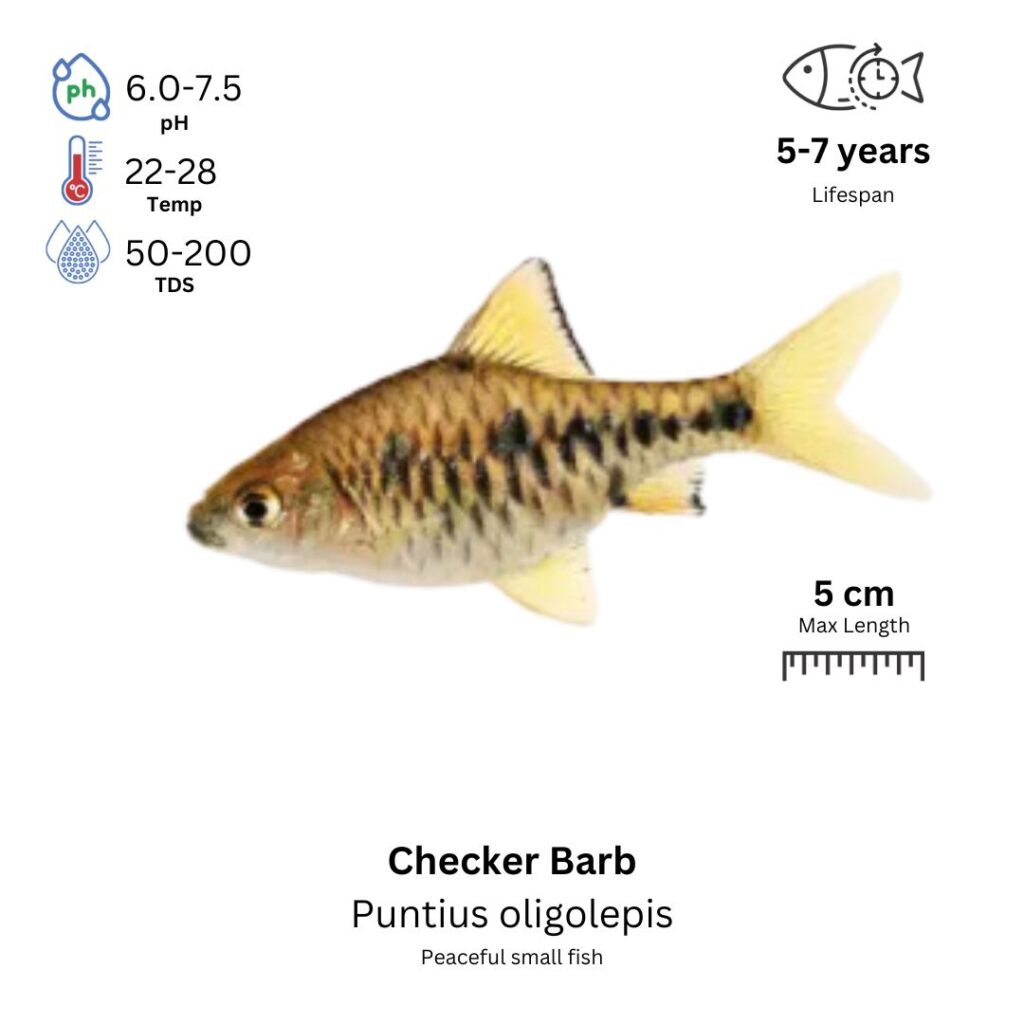Checker Barb
Puntius partipentazona

Description
The Checker Barb is a beautiful and energetic species known for its distinctive checkerboard-like pattern of alternating black and gold or silver markings along its body. These markings are especially prominent on the body and fins, making them easily recognizable and visually striking. The males typically display more vibrant coloration, especially when in breeding condition, with brighter and more contrasting patterns. The body of the fish is elongated and slightly compressed, and they have small barbels at the corners of the mouth. Checker Barbs are peaceful, active fish, often found swimming in schools. They are social and do well in groups, where their natural behavior and striking coloration are most visible.
Habitat Origin
Native to the freshwater rivers and streams of Southeast Asia, particularly in Myanmar, Thailand, and parts of Malaysia. They are typically found in slow-moving or still waters with abundant vegetation and submerged rocks. These fish thrive in slightly acidic to neutral waters with low to moderate water flow.
Aquarium
Ideal Number in Aquarium: At least 6 individuals, as they are schooling fish and feel more secure in groups.
Favorite Food

Checker Barbs are omnivores and will accept a variety of foods, including high-quality flake food, micro pellets, and live or frozen foods such as brine shrimp, daphnia, and bloodworms. They will also graze on algae and plant matter in the tank. A varied diet helps ensure that they maintain their health and vibrant coloration.
Behavior:
Checker Barbs are peaceful and active fish that do well in groups. They are lively swimmers and are often found in the middle and upper regions of the tank. These fish are not aggressive and are ideal for community tanks, as they do well with other small, peaceful species. They are social and enjoy swimming together in schools, making them an engaging species to observe. However, they can become shy or stressed if housed alone or in small groups, so it’s important to keep them in a school of at least 6. While peaceful, they may occasionally display some territorial behavior, particularly around feeding time or when space is limited.
Special Care:
Checker Barbs thrive in a well-planted tank with plenty of hiding spots, such as plants, rocks, and driftwood. A fine gravel or sandy substrate is ideal for them to forage and graze naturally. Regular water changes and good filtration are necessary to maintain clean water, as these fish are sensitive to poor water conditions. They prefer slightly acidic to neutral water and benefit from stable water parameters. Moderate water flow is also recommended to mimic their natural habitat.
Compatibility with Other Fish:
Yes, Checker Barbs are compatible with a wide variety of peaceful species, such as other barbs, tetras, rasboras, and small catfish. They are ideal for community tanks with other non-aggressive fish that swim at different levels. However, they may become stressed or shy if housed with overly aggressive species. Due to their active nature, they should be housed with species that can tolerate their swimming speed and energetic behavior.
Breeding Setup
A dedicated breeding tank is strongly recommended for Checker Barbs to ensure controlled water conditions and prevent egg predation. A 40-liter (10-gallon) aquarium is ideal, offering ample space for adult fish to spawn and for fry to develop afterward. Maintain a pH of 6.5–7.5, temperature between 24°C and 28°C (75–82°F), and GH between 4–12 dGH. Use a gentle sponge filter or low-flow internal filter to maintain clean water without disturbing the eggs. Set up the tank with fine gravel or bare-bottom, and add live plants such as Java moss, Hornwort, or Anubias, as well as floating plants for added cover and egg-laying surfaces. Provide moderate lighting, avoiding bright, intense light to simulate natural spawning conditions.
Conditioning for Breeding
To prepare Checker Barbs for spawning, feed them a high-protein, varied diet. Include live foods like brine shrimp, daphnia, and bloodworms, alongside high-quality flakes and frozen foods such as mysis shrimp. Well-fed and healthy fish are more likely to breed successfully. Maintain weekly water changes of around 25% to support clean, stress-free conditions. A fresh water environment mimics natural spawning triggers and improves reproductive health.
Spawning Process
Checker Barbs are egg-scatterers that typically spawn in low-light conditions, either in the early morning or late evening. During spawning, males display their bright fins and actively chase females. A female may lay up to 100 adhesive eggs that stick to plants, substrate, or tank decor. After the spawning is complete, remove the adult fish immediately, as they may consume the eggs. This step is critical to ensure a high fry survival rate.
Fry Care
The eggs will hatch in about 24–48 hours, depending on the tank temperature. The fry will initially remain still, relying on their yolk sacs for nourishment. Once they become free-swimming, begin feeding them with infusoria, liquid fry food, or rotifers. As they grow, introduce baby brine shrimp for added nutrition. Maintain excellent water quality with daily 10–15% water changes and monitor parameters closely—stable temperature (24–28°C), low ammonia, and zero nitrites are essential for healthy fry development.
Important Notes
Checker Barbs typically reach breeding maturity at around 6–12 months of age. Males are more colorful and slender, especially during spawning, while females are larger and rounder when gravid. To prevent breeding failure due to stress, maintain a stable environment with no sudden changes in temperature or pH. Avoid overcrowding and aggressive tankmates. A calm, well-managed tank helps ensure successful spawning and fry development.
